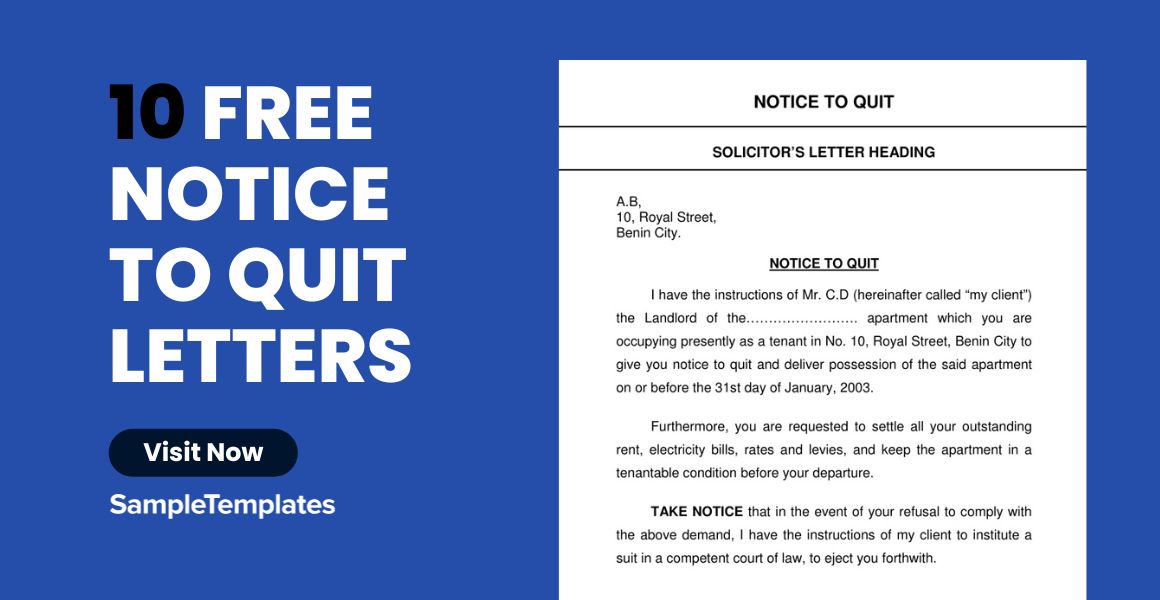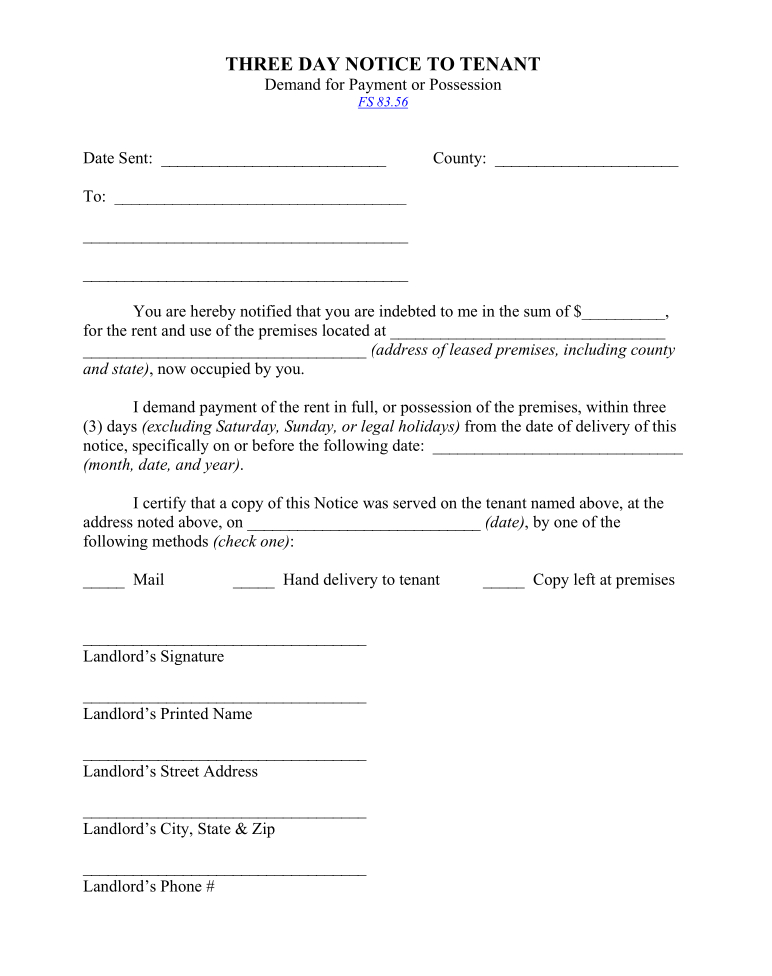A Sample Notice to Quit Letter Template is an essential tool for landlords and property managers. This template serves as a formal document to inform tenants of the need to vacate a property. Crafted with legal precision, it is crucial for ensuring compliance with state-specific regulations and rental agreements. Ideal for U.S. property management scenarios, these templates streamline the eviction process, providing a clear and professional approach to handling tenant transitions. With the right Notice to Quit Letter, landlords can effectively communicate their requirements, maintaining legal integrity and fostering a smooth changeover in tenancy.
1. Notice To Quit Letter Sample
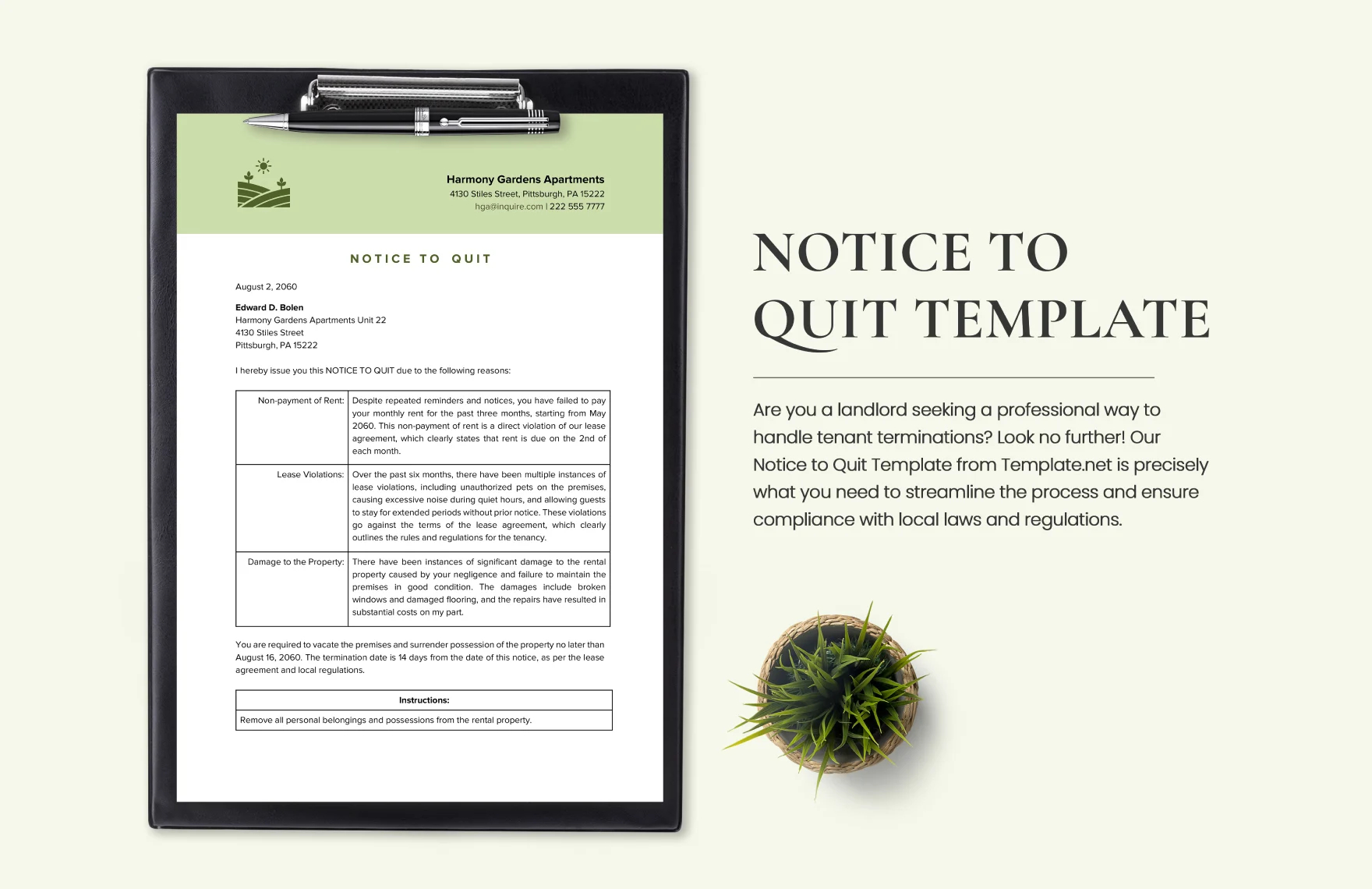
2. 5 Day Notice to Quit Letter Template
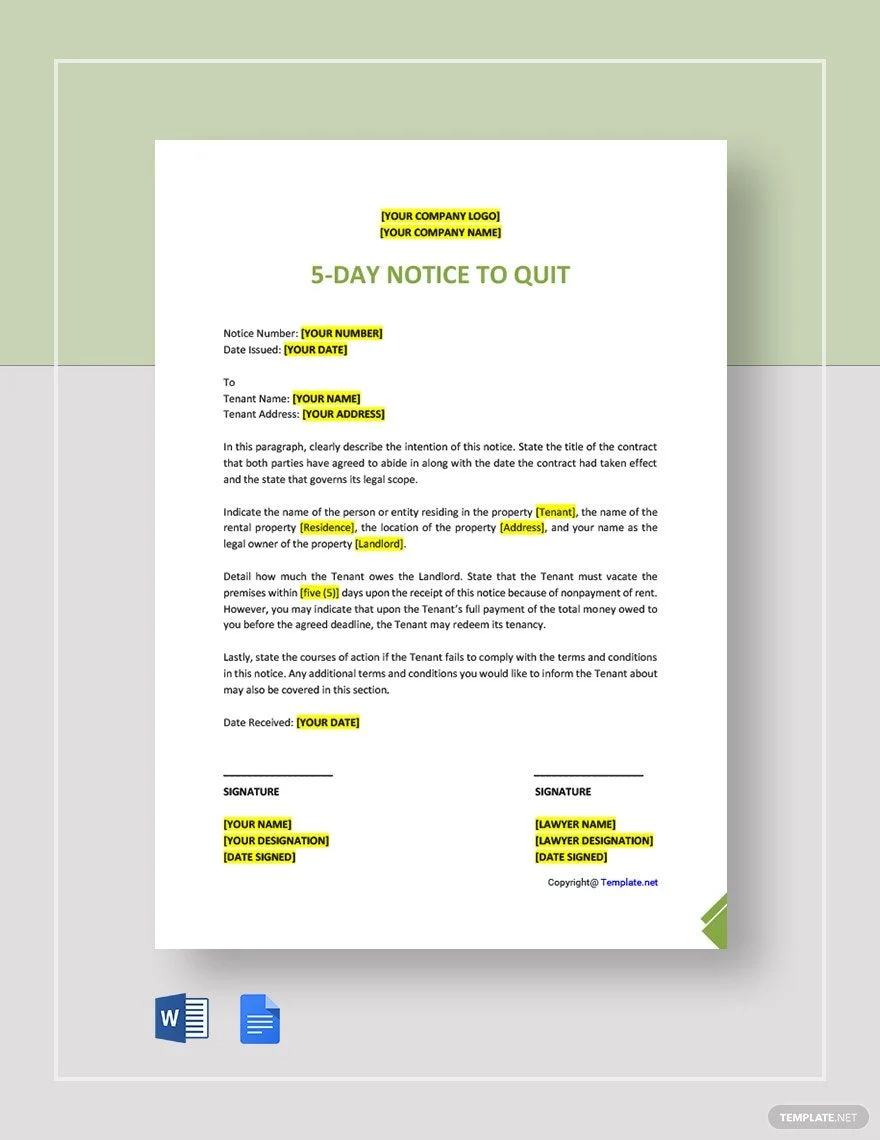
How do I write a quit notice letter?
Writing a quit notice letter, commonly known as a notice to quit, is a crucial step in the tenant eviction process. It serves as a formal declaration from a landlord to a tenant, stating that the tenant must vacate the rented property. Here’s a guide to help you craft an effective quit notice letter:
Understanding Local Laws
Before drafting a quit notice letter, it’s imperative to understand the specific landlord-tenant laws in your state. These laws dictate the necessary length of notice, reasons for eviction, and the acceptable delivery methods of the notice. For example, some states require a 30-day notice for month-to-month tenancies, while others may demand a 60 or 90-day period, especially for longer leases or specific circumstances like non-payment of rent.
Tenant Information Accuracy
Ensure that you have accurate details of the tenant, including their full name and the address of the rental property. This is crucial to avoid any legal disputes or misunderstandings. Inaccurate information can lead to the notice being legally invalid, which could further complicate the eviction process.
Formal Letter Structure
A professional presentation of the notice can significantly impact its reception and adherence. Start with a formal letterhead, if available, to convey the seriousness of the matter. The letter should be clear, concise, and free of any ambiguous language that could be misinterpreted.
Date and Tenant Addressing
Clearly state the date when the notice is written, as this establishes the timeline for the tenant to act. Address the tenant formally by their full name to personalize the notice and ensure it reaches the intended recipient.
Purpose and Reason for Eviction
The main body of the letter should explicitly state that it serves as a notice to quit. If your state’s laws require it, include the specific reason for the eviction, such as lease violations or non-payment of rent. This clarity helps prevent any misunderstandings and strengthens your position in case of a legal dispute.
Notice Period and Lease References
Mention the exact date by which the tenant is required to vacate the property, aligning with the notice period mandated by state law. If the eviction is due to a lease violation, reference the specific clauses in the lease agreement that the tenant has breached. This reinforces the legality of your notice.
Resolution Opportunities
In certain situations, like late rent payments, you might offer a chance for the tenant to rectify the issue. For instance, paying overdue rent by a specified date could nullify the eviction process. This approach can sometimes lead to a more amicable resolution and is often appreciated by tenants.
Legal Compliance Disclaimer
Include a statement acknowledging that the notice is in full compliance with state laws and represents a formal request for the tenant to vacate the property. This can be crucial in legal proceedings as it demonstrates your adherence to legal protocols.
Signature and Delivery
Your signature finalizes the document, indicating your commitment to the eviction process if the notice is not adhered to. Deliver the notice in accordance with state laws, which may include methods like certified mail, personal delivery, or posting on the property in a conspicuous place.
Crafting an effective quit notice letter is a vital skill in property management. It requires a balance of professionalism, legal knowledge, and clarity. By adhering to these guidelines, landlords can ensure their notices are legally sound, reducing the potential for disputes and facilitating a smoother transition in tenancy management.
3. Notice to Quit for Non Payment of Rent Template
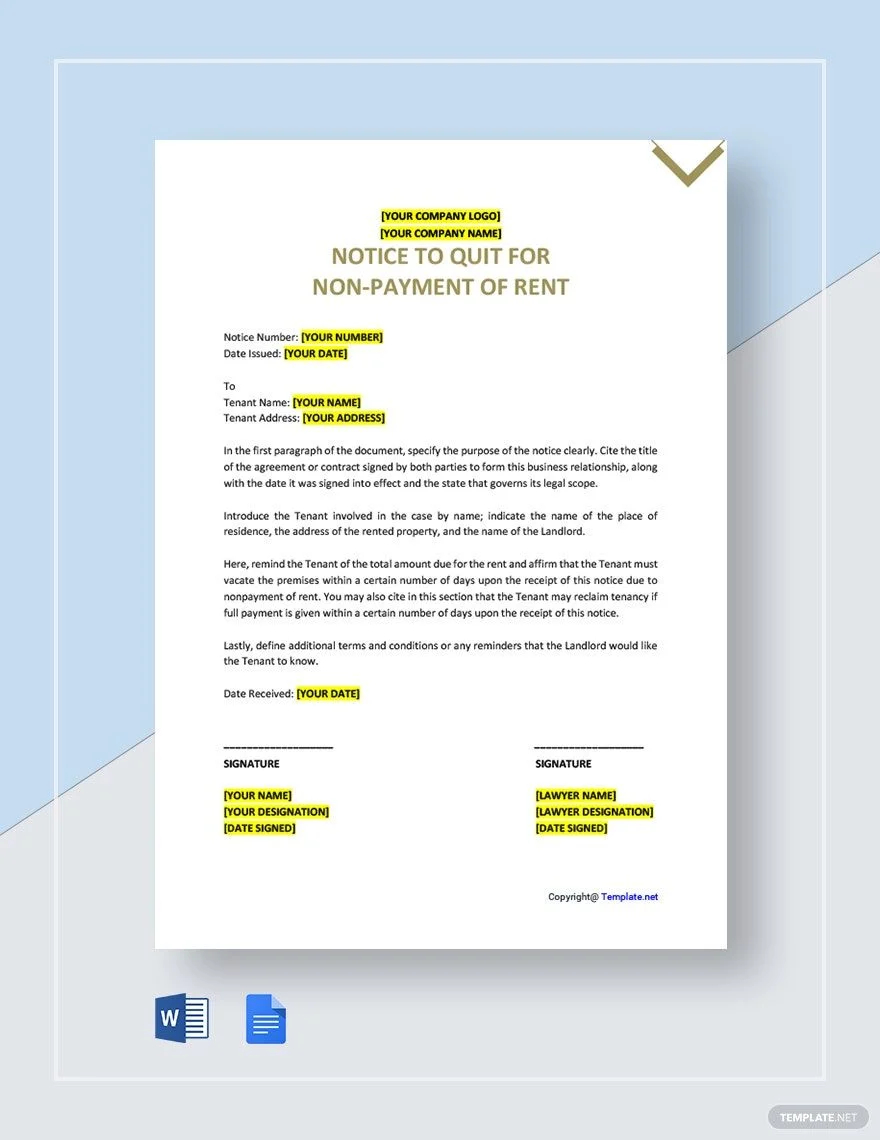
4. Sample Notice to Quit Letter
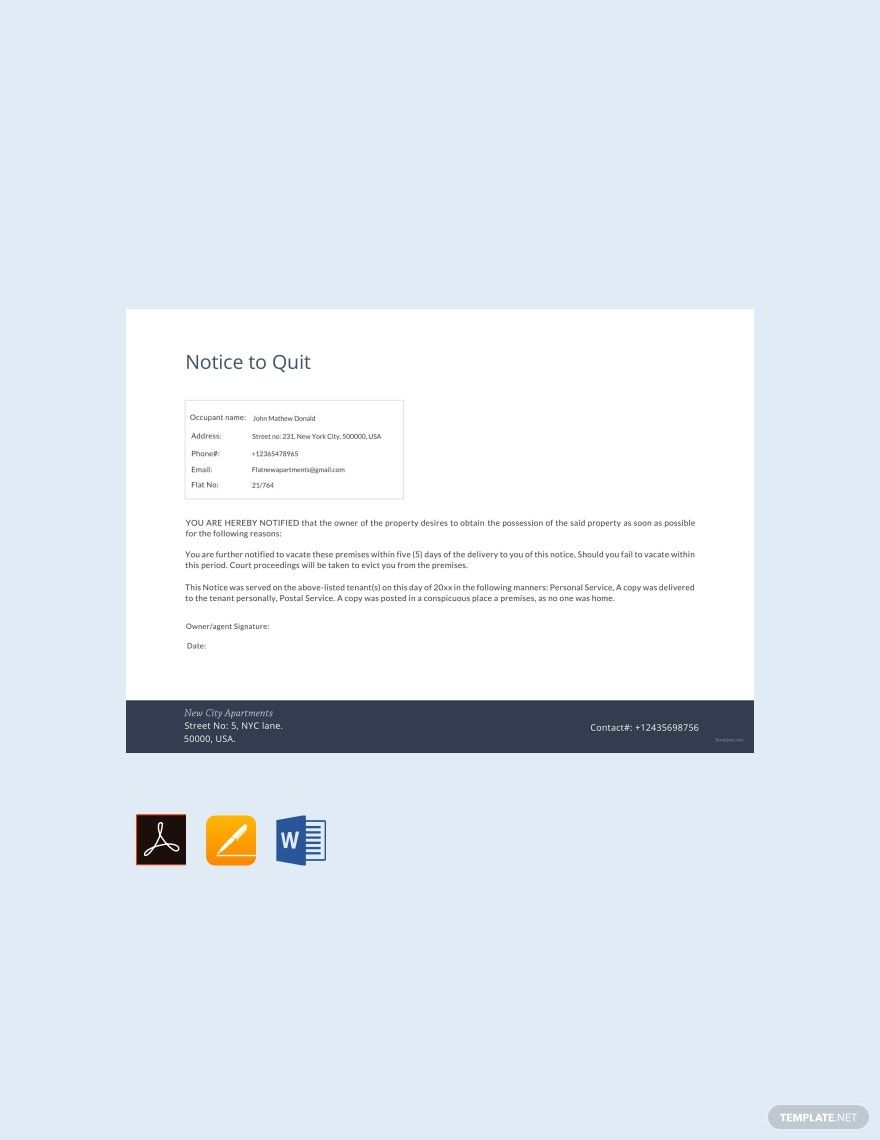
Reasons for Sending a Notice to Quit
A Notice to Quit is a critical document in property management, serving as a formal communication from a landlord to a tenant regarding the termination of their tenancy. This notice is not only a legal requirement in many jurisdictions but also a fundamental step in the eviction process. Understanding the various reasons for sending a Notice to Quit is essential for landlords to manage their properties effectively and within the bounds of the law.
Non-Payment of Rent
One of the most common reasons for issuing a Notice to Quit is non-payment of rent. When tenants fail to pay their rent by the due date, landlords have the right to initiate the eviction process. Typically, landlords provide a grace period as stipulated in the lease agreement, after which they can send a Notice to Quit, demanding either payment of the overdue rent or vacating of the premises.
Violation of Lease Terms
Lease agreements contain specific terms that tenants are required to follow. These terms may include rules regarding pets, noise levels, subletting, or property maintenance. If a tenant violates any of these terms, the landlord can issue a Notice to Quit. This notice usually gives the tenant a chance to correct the violation within a specified time frame before further action is taken.
Property Damage
Significant damage to the property caused by the tenant is another reason to issue a Notice to Quit. Landlords expect their properties to be maintained in good condition. When tenants cause extensive damage, whether intentionally or due to negligence, it can lead to a termination of their tenancy.
Illegal Activities
Engaging in illegal activities on the rental property is a serious breach of the lease and a valid ground for eviction. Landlords can issue a Notice to Quit if they discover activities like drug dealing or other criminal behavior on their property. In such cases, the notice period might be shorter due to the severity of the breach.
End of Lease Period
In some cases, a Notice to Quit is necessary when the lease period comes to an end, and the landlord does not wish to renew it. This situation is typical in fixed-term leases, where the tenancy agreement is for a specified period. Once this period expires, the landlord can ask the tenant to vacate the property if they choose not to renew the lease.
Sale of Property
Landlords might decide to sell their rental property, which requires the tenants to vacate. In this case, a Notice to Quit informs tenants of the need to leave the property by a specific date. The notice period for such cases usually aligns with state laws or the terms outlined in the lease agreement.
Sending a Notice to Quit is a significant step in property management and should be handled with care and legal understanding. Whether it’s due to non-payment of rent, lease violations, property damage, illegal activities, the end of a lease period, or the sale of the property, each situation requires a tailored approach. By adhering to legal requirements and maintaining clear communication, landlords can navigate these challenges effectively, ensuring their rights and property are protected while also respecting the rights of their tenants.
5. 3 Days Notice to Quit Letter For Tenant Sample
6. Formal Notice To Quit Letter Sample

7. 3 Day Notice to Quit for Residential Letter Template
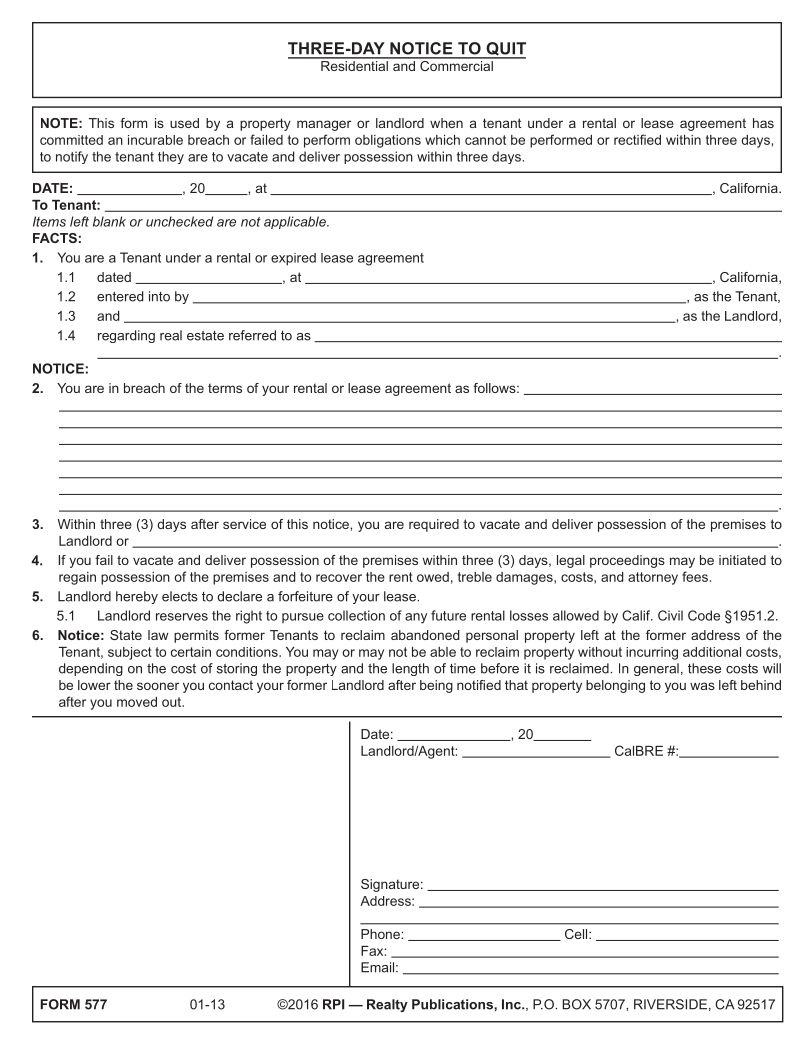
Importance of Accurate Identification in a Notice to Quit
A Notice to Quit is a formal legal document used by landlords to initiate the process of terminating a tenancy. Its effectiveness and legal standing largely depend on accurately identifying and listing all relevant parties. Knowing who should be included in this notice is crucial for ensuring the process is legally sound and enforceable.
Primary Tenant(s)
The most obvious individual to be listed on a Notice to Quit is the primary tenant or tenants. These are the persons who have signed the lease agreement and have a legal relationship with the landlord. The notice must include their full legal names as stated in the lease. This ensures that the document is officially and directly addressing those responsible for adhering to the lease terms.
All Adult Occupants
In addition to the primary tenant(s), it is critical to include the names of all adult occupants residing in the property. These might be individuals who haven’t signed the lease but live in the rental unit, such as adult children, partners, or roommates. Including all adult occupants ensures that everyone who has an established residency at the property is formally notified, thereby preventing potential legal challenges that could arise from uninformed occupants.
Subtenants
If the primary tenant has sublet a part or all of the property, it is important to include the subtenant’s name in the Notice to Quit. This is especially crucial if the subletting was done with the landlord’s knowledge and consent. In some jurisdictions, subtenants have certain rights that must be respected, and failing to notify them can lead to complications in the eviction process.
Legal Representatives or Guarantors
In some cases, tenants may have legal representatives or guarantors, especially in commercial leases or situations where a tenant’s legal capacity is limited. These representatives or guarantors, if formally part of the lease agreement, should also be listed on the Notice to Quit. They play a role in the legal and financial aspects of the tenancy and therefore need to be informed about any actions that affect the lease.
Correctly Addressing Minors
While minors living in the rental property should not be listed as responsible parties in the Notice to Quit, it’s important to be aware of their presence. In cases where the eviction process may lead to a court case, the presence of minors can sometimes be a factor in the court’s decision, especially in regard to timelines and humanitarian considerations.
The accuracy and completeness of a Notice to Quit are pivotal in ensuring the eviction process proceeds smoothly and legally. Including all relevant parties – from primary tenants and adult occupants to subtenants and legal representatives – is essential. This comprehensive approach safeguards the landlord’s position and ensures that all parties involved are duly notified and given the opportunity to respond to the notice, as dictated by law and the terms of the lease agreement.
8. Sample Notice Letter to Quit for Non Payment of Rent

9. Notice Letter of Intent to Vacate Template
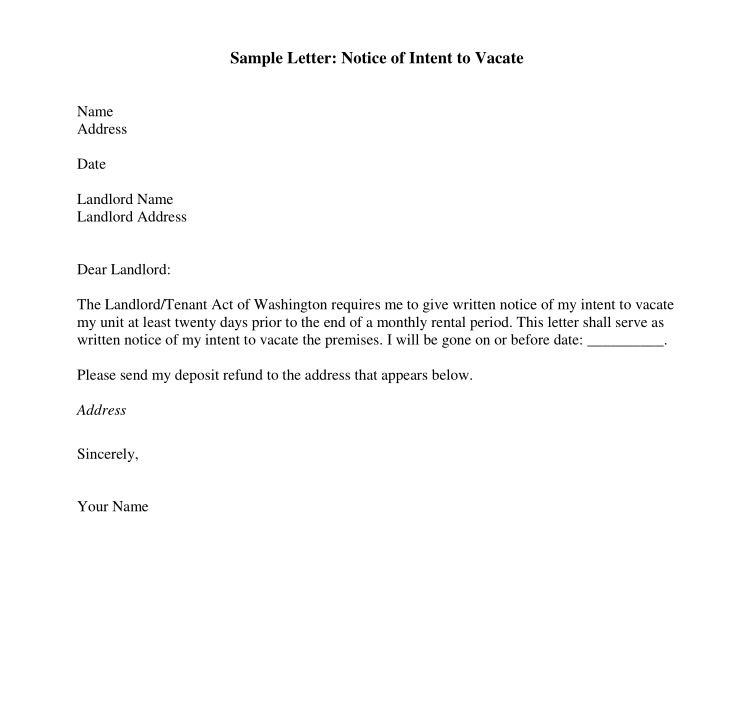
How Do You Send a Notice to Quit?
Sending a Notice to Quit is a critical step in the eviction process, requiring precision and adherence to legal protocols. This notice serves as a formal declaration from the landlord to the tenant, indicating the need to vacate the property. The method of delivery can significantly impact the legal validity and effectiveness of the notice.
Understanding State Laws and Lease Agreements
Before sending a Notice to Quit, familiarize yourself with state-specific landlord-tenant laws and the terms of the lease agreement. These regulations dictate the acceptable methods of delivery and any specific requirements, such as the notice period and the information to be included in the notice.
Choosing the Right Delivery Method
The most commonly used methods to deliver a Notice to Quit include:
Personal Delivery: Handing the notice directly to the tenant is often the most straightforward method. If the tenant is not available, it can sometimes be given to an adult residing in the same household. Documenting this delivery, possibly with a witness, is crucial for legal purposes.
Certified Mail: Sending the notice via certified mail with a return receipt requested provides proof of delivery. This method ensures that there is a record of the tenant receiving the notice, which can be critical in legal proceedings.
Posting on the Premises: In some cases, landlords may be allowed to post the notice in a conspicuous place on the property, such as the front door. This is typically used when other methods are not feasible. Taking a photograph as proof of posting can be helpful.
Documenting the Process
Regardless of the method chosen, documenting every step of the process is vital. Keep copies of the notice, any postal receipts, and make notes of dates and times of delivery attempts. This documentation can be invaluable in the event of a legal dispute.
Following Up
After sending the notice, it’s important to follow up if you do not receive a response from the tenant. This might involve additional communication or beginning formal eviction proceedings if the tenant fails to comply with the Notice to Quit.
Sending a Notice to Quit is a process that requires careful attention to legal details and documentation. By understanding and adhering to state laws, choosing an appropriate delivery method, and meticulously documenting the process, landlords can ensure that they are acting within legal bounds and protecting their rights as property owners. This approach also respects the rights of the tenant and helps to maintain a clear and professional landlord-tenant relationship.
How to Serve a Notice To Quit?
Serving a Notice to Quit is a formal step in the eviction process, where a landlord informs a tenant that they must leave the rental property. This legal document must be served correctly to ensure the eviction process is valid and enforceable. Understanding how to serve a Notice to Quit is crucial for landlords to manage their properties effectively and within legal boundaries.
Familiarizing with Local Jurisdiction Laws
Before serving a Notice to Quit, landlords must familiarize themselves with the specific landlord-tenant laws in their jurisdiction. These laws determine the acceptable methods of serving the notice, the required notice period, and other essential details like the format and content of the notice. Compliance with these laws is critical to avoid legal challenges and ensure the process is smooth and enforceable.
Preparing the Notice to Quit
The Notice to Quit should include all necessary information such as the tenant’s name, the rental property address, the reason for eviction, and the date by which the tenant must vacate the property. It should be written in clear, unambiguous language and in compliance with state laws regarding eviction notices.
Choosing the Method of Service
Common methods of serving a Notice to Quit include:
Personal Delivery: Delivering the notice directly to the tenant ensures immediate receipt. If the tenant is not available, it may be permissible to leave the notice with a responsible adult at the residence.
Certified Mail: Sending the notice via certified mail with a return receipt offers proof that the tenant received the notice. This method creates a record of delivery, which can be crucial in legal proceedings.
Posting on the Property: In some jurisdictions, posting the notice in a visible area on the property, like the front door, is an acceptable method of service, especially when other methods are not possible.
Documenting the Service
Documenting the service of the Notice to Quit is essential. Keep copies of the notice, postal receipts, and note the date and time of service. If the notice is posted on the property, taking a photograph as evidence can be helpful.
Following Legal Protocols
After serving the notice, landlords should be prepared to follow through with legal action if the tenant fails to comply. This may involve filing for an eviction with the local court. It’s important to continue adhering to legal procedures throughout this process to ensure that the eviction is lawful and enforceable.
Serving a Notice to Quit is a significant responsibility that requires understanding and adherence to legal requirements. By preparing a clear and compliant notice, choosing an appropriate method of service, and meticulously documenting the process, landlords can effectively and legally manage the eviction process. This approach not only protects the landlord’s rights but also ensures that the tenant’s rights are respected throughout the process.
10. 14 Day Notice Letter to Quit Template
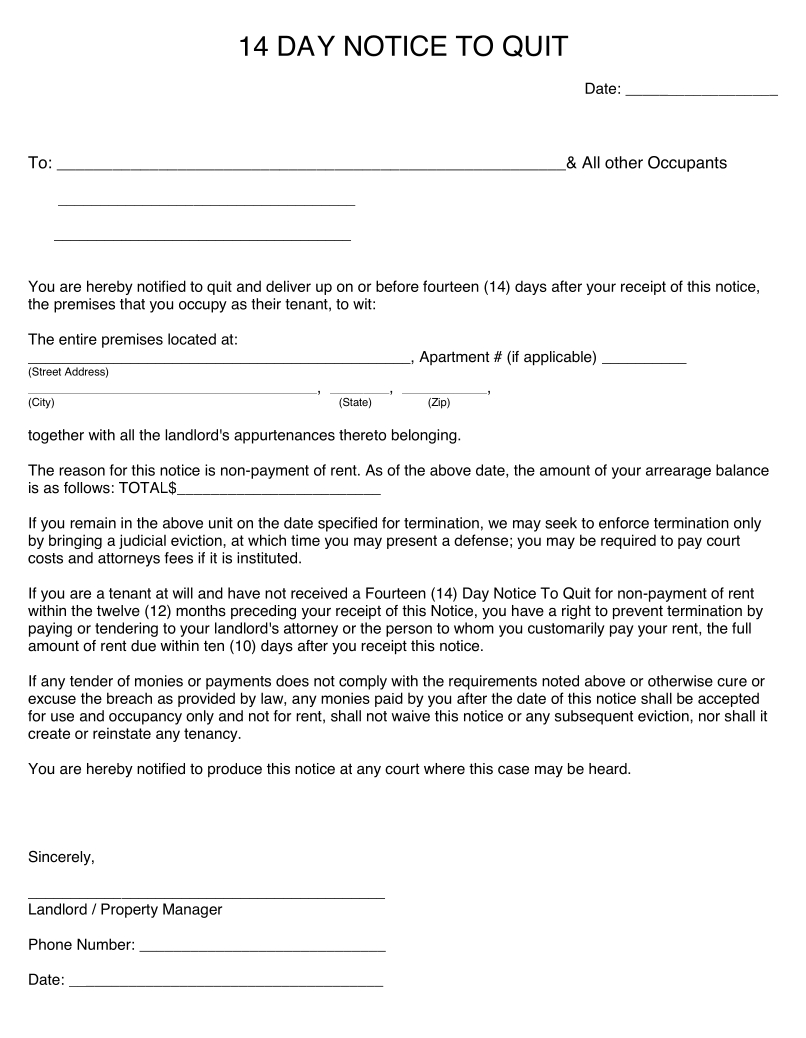
A Notice to Quit Letter is a formal document sent by a landlord to a tenant, indicating the need for the tenant to vacate the rental property. It’s typically used in situations where the tenant has violated lease terms or the lease is ending.What is a Notice to Quit Letter?
Landlords should issue a Notice to Quit in circumstances such as non-payment of rent, lease violations, property damage, engaging in illegal activities on the premises, or when the lease term is ending and the landlord chooses not to renew it.When should a landlord issue a Notice to Quit?
The acceptability of emailing a Notice to Quit depends on your state’s laws. Some jurisdictions may allow electronic delivery, while others require physical delivery, such as personal delivery or certified mail.Can I email a Notice to Quit to my tenant?
A Notice to Quit should include the tenant’s name, the property address, the reason for the notice, the date by which the tenant must vacate the property, and a statement of compliance with state laws.What should be included in a Notice to Quit?
While you don’t necessarily need a lawyer to draft a Notice to Quit, consulting with a legal professional can ensure that the notice complies with state laws and lease terms.Do I need a lawyer to draft a Notice to Quit?
A landlord can rescind a Notice to Quit, typically in situations where the tenant remedies the issue that led to the notice, such as paying overdue rent or correcting a lease violation.Can a Notice to Quit be rescinded or canceled?
Related Posts
-
FREE 9+ Sample Notice of Termination Letter Templates in MS Word | PDF
-
FREE 7+ How to Write a Resignation Letter with a Notice Period [ With Samples ]
-
FREE Tips on What to Put in Your Two Weeks Notice [ Guides and Samples ]
-
FREE 10+ Sample Final Notice Letter Templates in PDF | MS Word | Pages
-
FREE 11+ Sample 30 Day Notice Letter Templates in PDF | MS Word | Pages
-
FREE 26+ Sample Notice Letter Templates in PDF | MS Word
-
Notice Period Resignation Letter Samples & Templates
-
FREE 12+ Notice of Cancellation Letter Templates in PDF | MS Word | Pages | Google Docs
-
FREE 6+ Sample 30 Days Notice Letter Templates in MS Word | PDF
-
FREE 11+ Resignation Letters No Notice Templates in PDF | MS Word | Google Docs | Pages
-
FREE 6+ Sample Resignation Letter Short Notice Templates in MS Word | PDF
-
FREE 7+ Sample Resignation Letters 2 Week Notice Templates in PDF | MS Word
-
FREE When to Quit Your Internship [ 7+ Samples ]
-
FREE Tips for Quitting Your Job Gracefully [ With Samples ]
-
FREE Keeping Great Relationships after Quitting Your Job [ With Samples ]
